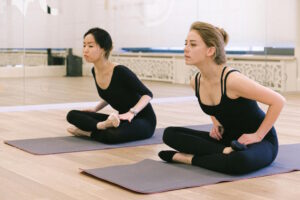
Pilates workouts have gained immense popularity in recent years, thanks to their holistic approach to fitness and overall well-being. If you’re new to Pilates or considering starting, you’re in the right place. In this comprehensive guide, I’ll delve into everything you need to know as you embark on your Pilates journey.
What is the best introduction to Pilates?
The best introduction to Pilates begins with understanding its core principles and philosophy. Pilates is a mind-body exercise system developed by Joseph Pilates in the early 20th century. It focuses on improving strength, flexibility, and overall body awareness through controlled movements. The key principles of Pilates include:
1. Breath Control: Pilates emphasizes conscious breathing techniques that coordinate with each movement, promoting relaxation and improved oxygenation of muscles.
2. Centering: The core, often referred to as the powerhouse, is the focal point of Pilates. Exercises originate from this center, promoting core strength and stability.
3. Concentration: Mindful attention to each movement is essential in Pilates. It’s not about quantity but quality, ensuring precise, controlled actions.
4. Control: Pilates exercises require precise control of your body, emphasizing fluid and graceful movements.
5. Precision: Every movement has a purpose in Pilates. Precision is key to achieving the desired results and avoiding injury.
6. Flow: Pilates exercises are meant to be performed in a continuous, flowing manner, enhancing overall body coordination.
To get started, consider taking an introductory class or working with a certified Pilates instructor. This ensures you learn the correct techniques and form from the beginning, setting a strong foundation for your practice.
How do I start Pilates workout?
Starting a Pilates workout is an exciting endeavor. Here’s a step-by-step guide to help you begin:
1. Research and Choose a Pilates Studio or Instructor: Look for reputable studios or certified instructors in your area. Consider the location, class schedules, and reviews.
2. Determine Your Goals: Define your fitness goals and discuss them with your instructor. Whether it’s improved flexibility, core strength, or stress relief, Pilates can be tailored to meet your needs.
3. Wear Comfortable Clothing: Choose comfortable, breathable attire that allows for easy movement. Pilates is typically done barefoot or with grip socks.
4. Basic Equipment: Depending on the studio, you might use equipment like a reformer, mat, or props. Your instructor will guide you on which equipment is suitable for your level.
5. Start with a Beginner’s Class: If you’re new to Pilates, opt for a beginner’s class. It’s a safe and effective way to learn the fundamentals and build a strong foundation.
6. Listen and Learn: Pay close attention to your instructor’s cues on breathing, form, and technique. Pilates is precise, and proper execution is key to reaping its benefits.
7. Practice Regularly: Consistency is key in Pilates. Aim to attend classes regularly, typically 2-3 times a week, to see progress.
Can I learn Pilates by myself?
While it’s possible to learn Pilates on your own, it’s highly recommended, especially for beginners, to start under the guidance of a certified instructor. Pilates exercises can be intricate, and precise alignment and form are crucial for safety and effectiveness.
However, if you’re experienced and confident in your understanding of Pilates principles, you can complement your studio or instructor-led sessions with at-home practice. There are numerous online resources, videos, and apps that provide guided Pilates workouts suitable for different levels.
How often should a beginner do Pilates?
For beginners, consistency is more important than frequency. It’s advisable to start with 2-3 sessions per week. This allows your body to adapt to the exercises and build strength progressively without overexertion.
As you become more experienced and your body adapts, you can gradually increase the frequency and duration of your Pilates workouts. However, it’s crucial to listen to your body and avoid pushing yourself too hard, as Pilates is about controlled, mindful movements.
Summarizing the Answers
In summary, the best introduction to Pilates involves understanding its core principles and philosophy. To start Pilates workouts, research and choose a reputable studio or instructor, set clear goals, wear comfortable clothing, and begin with a beginner’s class. While learning Pilates by yourself is possible, it’s recommended to start with professional guidance. Beginners should aim for 2-3 sessions per week, gradually increasing frequency and intensity as they gain experience. Remember that Pilates is a journey that promotes overall well-being through mindful and controlled movements.